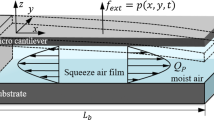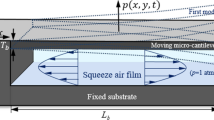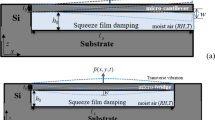Abstract
This paper discussed the effect of environmental conditions (moisture and temperature) on the quality factors (Q-factor) of micro-electro-mechanical systems (MEMS) cantilever beam resonators in wide range of gas rarefaction (pressure (p), and accommodation coefficients (ACs)), and flexural mode of resonator. The modified molecular gas lubrication (MMGL) equation is applied for modeling the dominant squeeze film damping (SFD) problem on the quality factor of MEMS cantilever beam resonators to discuss the effect of environmental conditions. The external SFD and the internal structure damping (thermoelastic damping) and support loss) are accurately taken into account. Effective viscosity, which is ratio of dynamic viscosity and Poiseuille flow rate of moist air, is utilized to modify the MMGL equation to consider the environmental effects of moisture and temperature in gas rarefaction. In low pressures, mean free path changes more significantly with relative humidity and temperature than that of dynamic viscosity of moisture in gas rarefaction. Thus, effect of environmental conditions such as moisture and temperature must be discussed to improve Q-factors of MEMS cantilever beam resonators in wide range of gas rarefaction (p and ACs) and flexural modes of resonator. The results showed that Q-factor of SFD decreases significantly as moisture and temperature increase at higher gas rarefaction (lower p, and ACs), while Q-factor of SFD decreases and then increases slightly as moisture and temperature increase at lower gas rarefaction (higher p, and ACs). The total Q-factor is highly sensitive to the relative humidity and temperature in higher gas rarefaction (lower p and ACs) and lower flexural modes of resonator.










Similar content being viewed by others
References
Binnig, G., & Quate, C. F. (1986). Atomic force microscope. Physical Review Letters, 56(9), 930–934.
Thundat, T., Warmack, R. J., Chen, G. Y., & Allison, D. P. (1994). Thermal and ambient-induced deflections of scanning force microscope cantilevers. Applied Physics Letters, 64, 2894–2896.
Takahashi, H., Dung, N. M., Matsumoto, K., & Shimoyama, I. (2012). Differential pressure sensor using a piezoresistive cantilever. Journal of Micromechanics and Microengineering, 22, 055015–055021.
Chennippan, M., Bhaskaran, P. E., Adhulrasheed, I. S. K., Subramaniam, T., & Govindasamy, R. (2020). Vibration signals based bearing defects identification through online monitoring using LABVIEW. Journal Européen des Systèmes Automatisés, 53, 187–193.
Priyanka, E. B., Maheswari, C., Ponnibala, M., & Thangavel, S. (2019). SCADA based remote monitoring and control of pressure & flow in fluid transport system using IMCPID controller. Advances in Systems Science and Applications, 03, 140–162.
Priyanka, E. B., Thangavel, S., & Pratheep, V. G. (2020). Enhanced digital synthesized phase locked loop with high frequency compensation and clock generation. Sensing and Imaging, 21–43.
Baller, M. K., Lang, H. P., Fritz, J., Gerber, Ch., Gimzewski, J. K., Drechsler, , et al. (2000). A cantilever array-based artificial nose. Ultramicroscopy, 82, 1–9.
Lang, H. P., Hegner, M., & Gerber, C. (2005). Cantilever array sensors. Materialstoday, 8(4), 30–36.
Pratheep, V. G., Priyanka, E. B., & Prasad, P. H. (2019). Characterization and analysis of natural fibre-rice husk with wood plastic composites. IOP Conf. Series: Materials Science and Engineering, 561, 012066.
Gupta, A., Akin, D., & Bashir, R. (2004). Single virus particle mass detection using microresonators with nanoscale thickness. Applied Physics Letters, 84(11), 1976–1978.
Tamayo, J., Humphris, A. D. L., Malloy, A. M., & Miles, M. J. (2001). Chemical sensors and biosensors in liquid environment based on microcantilevers with amplified quality factor. Ultramicroscopy, 86, 167–173.
Cyril, V., Isabelle, D., Stephen, M. H., Fabien, J., & Andreas, H. (2008). Analysis of resonating microcantilevers operating in a viscous liquid environment. Sensors and Actuators A, 141, 43–51.
Singh, P., & Yadava, R. D. S. (2020). Stochastic resonance induced performance enhancement of MEMS cantilever biosensors. J. Phys. D: Appl. Phys. 53(46).
Fischeneder, M., Kucera, M., Hofbauer, F., Pfusterschmid, G., Schneider, M., & Schmid, U. (2018). Q-factor enhancement of piezoelectric MEMS resonators in liquids with active feedback. Sensor Actuat B-Chem., 260, 198–203.
Blake, N. J., & Raj, M. (2012). Biosensing using dynamic-mode cantilever sensors: A review. Biosensors & Bioelectronics, 32(1), 1–18.
Schneider, M., Pfusterschmied, G., Patocka, F., & Schmid, U. (2020). High performance piezoelectric AlN MEMS resonators for precise sensing in liquids. Elektrotechnik & Informationstechnik., 137(3), 121–127.
Amin, E., Habib, B. G., & Mousa, S. (2019). A Novel biosensor based on micromechanical resonator array for lab-on-a-chip applications. Sensing and Imaging, 20, 39.
Hosaka, H., Itao, K., & Kuroda, S. (1995). Damping characteristics of beam-shaped micro-oscillators. Sensors and Actuators A: Physical, 49(1–2), 87–95.
Zener, C. (1937). Internal friction in solids I theory of internal friction in reeds. Physical Review, 52(3), 230–235.
Zener, C. (1938). Internal friction in solids II general theory of thermoelastic internal friction. Physical Review, 53(1), 90–99.
Lifshitz, R., & Roukes, M. L. (2000). Thermoelastic damping in micro- and nanomechanical systems. Physical Review B, 61(8), 5600–5609.
Zhou, H., Li, P., & Zuo, W. (2016). Thermoelastic damping in microwedged cantilever resonator with rectangular cross-section. In: IEEE 2016 int. conf. on mechatronics and automation (ICMA), Harbin, China, 1590–1595.
Hao, Z., Erbil, A., & Ayazi, F. (2003). An analytical model for support loss in micromachined beam resonators with in-plane flexural vibrations. Sensors and Actuators A: Physical, 109(1–2), 156–164.
Jandak, M., Neuzil, T., Schneider, M., & Schmid, U. (2016). Investigation on different damping mechanisms on the Q factor of MEMS resonators. Procedia Engineering, 168, 929–932.
Yang, J., Ono, T., & Esashi, M. (2002). Energy dissipation in submicrometer thick single-crystal silicon cantilevers. Journal of Microelectromechanical Systems, 11(6), 775–783.
Kim, B., Hopcroft, M. A., Candler, R. N., Jha, C. M., Agarwal, M., Melamud, R., et al. (2008). Temperature dependence of quality factor in MEMS resonators. Journal of Microelectromechanical Systems, 17(3), 755–766.
Ghaffari, S., Ng, E. J., Ahn, C. H., Yang, Y., Wang, S., Hong, V., et al. (2015). Accurate modeling of quality factor behavior of complex silicon MEMS resonators. Journal of Microelectromechanical Systems, 24(2), 276–288.
Lee, J. W. (2011). Analysis of fuid-structure interaction for predicting resonant frequencies and quality factors of a microcantilever on a squeeze-film. Journal of Mechanical Science and Technology, 25(5), 3005–3013.
Bao, M., & Yang, H. (2007). Squeeze film air damping in MEMS. Sensors and Actuators A: Physical, 136(1), 3–27.
Pandey, A. K., & Pratap, R. (2007). Effect of flexural modes on squeeze film damping in MEMS cantilever resonators. Journal of Micromechanics and Microengineering, 17(12), 2475–2484.
Kim, S. J., Dean, R., Jackson, R. L., & Flowers, G. T. (2011). An investigation of the damping effects of various gas environments on a vibratory MEMS device. Tribology International, 44(2), 125–133.
Burg, T. P., & Manalis, S. R. (2003). Suspended microchannel resonators for biomolecular detection. Applied Physics Letters, 83(2), 2698–2700.
Nguyen, C. C., & Li, W. L. (2016). Effect of gas rarefaction on the quality factors of micro-beam resonators. Microsystem Technologies, 23, 3185–3199.
Nguyen, C. C., & Li, W. L. (2016). Effects of surface roughness and gas rarefaction on the quality factor of micro-beam resonators. Microsystem Technologies, 23(8), 3489–3504.
Nguyen, C. C., & Li, W. L. (2017). Influences of temperature on the quality factors of micro-beam resonators in gas rarefaction. Sensors and Actuators A: Physical, 261, 151–165.
Nguyen, C. C., Ngo, V. K. T., Le, H. Q., & Li, W. L. (2018). Influences of relative humidity on the quality factors of MEMS cantilever resonators in gas rarefaction. Microsystem Technologies, 25, 2767–2782.
Hosseinian, E., Theillet, P. O., & Pierron, O. N. (2013). Temperature and humidity effects on the quality factor of a silicon lateral rotary micro-resonator in atmospheric air. Sensors and Actuators A: Physical, 189, 380–389.
Nieva, P. M., McGruer, N. E., & Adams, G. G. (2006). Design and characterization of a micromachined fabry-perot vibration sensor for high-temperature applications. Journal of Micromechanics and Microengineering, 16(12), 2618–2631.
Hosseinzadegan, H., Pierron, O. N., & Hosseinian, E. (2014). Accurate modeling of air shear damping of a silicon lateral rotary micro-resonator for MEMS environmental monitoring applications. Sensors and Actuators A: Physical, 216, 342–348.
Jan, M. T., Ahmad, F., Hamid, N. H. B., Khir, M. H. B. M., Shoaib, M., & Ashraf, K. (2016). Experimental investigation of moisture and temperature effects on resonance frequency and quality factor of CMOS-MEMS paddle resonator. Microelectronics Reliability, 63, 82–89.
Hwang, C. C., Fung, R. F., Yang, R. F., Weng, C. I., & Li, W. L. (1996). A new modified Reynolds equation for ultrathin film gas lubrication. IEEE Transactions on Magnetics, 32(2), 344–347.
Li, W. L. (1999). Analytical modelling of ultra-thin gas squeeze film. Nanotechnology, 10(4), 440–446.
Li, W. L. (2002). A database for couette flow rate considering the effects of non-symmetric molecular interactions. Journal of Tribology, 124(4), 869–873.
Li, W. L. (2003). A database for interpolation of Poiseuille flow rate for arbitrary Knudsen number lubrication problems. Journal of the Chinese Institute of Engineers, 26(4), 455–466.
Li, W. L. (2004). Modeling of head/disk interface—an average flow model. Tribology Letters, 17, 669–676.
Li, W. L. (2008). Squeeze film effects on dynamic performance of MEMS μ-mirrors-consideration of gas rarefaction and surface roughness. Microsystem Technologies, 14(3), 315–324.
Hasan, M. H. (2018). Influence Of Environmental Conditions On The Response Of MEMS Resonators, Dissertation, University of Nebraska.
Morvay, Z. K., & Gvozdenac, D. D. (2008). Applied Industrial Energy and Environmental Management. in: Fundamentals for analysis and calculation of energy and environmental performance, (pp. 1–5), Wiley, Ltd.
Kreith, F., & Goswami, D. Y. (2005). The CRC HANDBOOK of Mechanical engineering. In: CRC Press LLC, (pp. 1385).
Tan, Z. (2014). Air pollution and greenhouse gases. Springer Science + Business Media, (pp. 33–34), Singapore.
ASHRAE. (2001). The 2001 ASHRAE Fundamentals Handbook. (pp. 6.2).
Saraireh M. (2012). Heat transfer and condesation of water vapour from humid air in compact heat exchangers. Doctor of Philosophy, Victoria University, (pp. 67), Footscray.
Leissa, A. W. (1969). Vibration of Plates, In: NASA, (pp. 1–6), Washington DC.
Nayfeh, A. H., & Younis, M. I. (2004). A new approach to the modeling and simulation of fexible microstructures under the effect of squeeze flm damping. Journal of Micromechanics and Microengineering, 14, 170–181.
COMSOL Multiphysics 5.5. (2021). Thermoelastic damping in a MEMS resonator, https://www.comsol.com/model/thermoelastic-damping-in-a-mems-resonator-1439. License Date to February 1, 2021.
Matthew, A. H., William, D. N., & Thomas, W. K. (2010). What is the young’s modulus of silicon? Journal of Microelectromechanical Systems, 19(2), 229–238.
Acknowledgments
This research was supported by the Institute for Computational Science and Technology (ICST), Contract Number: 08/2019/HĐ-KHCNTT in October 24th, 2019 and series number: 082019-311.
Author information
Authors and Affiliations
Corresponding author
Additional information
Publisher's Note
Springer Nature remains neutral with regard to jurisdictional claims in published maps and institutional affiliations.
Appendices
Appendix A
In Fig. 10, the Q factor of TED (QTED) is calculated as function of temperature (T) for various flexural modes of cantilever beam resonator. The result showed that QTED decreases as T increases for different modes of resonator. Also, QTED decreases more significantly as flexural modes of resonator increases because the TED increases with T and becomes dominantly in higher flexural mode of resonator. The calculated results of QTED from the present LR model [11] (Eq. 15 in [35]) showed good agreement with those obtained results from the Zener models [19, 20] (Eq. 14 in [35]), and those obtained results with COMSOL Multiphysics 5.5 [55] (Sect. "Quality Factors of MEMS Cantilever Beam Resonators" in [35]) in wide range of temperatures and resonator modes. Thus, the obtained results of QTED from the LR model, which are used in the present analysis, can be applied to calculate the total Q factor (QT) of MEMS cantilever beam resonators in wide range of temperature and flexural mode of resonator.
Appendix B
In Table 2, \(Q_{\sup }\) is calculated by the model of Hao et al. [23] (Eq. 18 in [35]) for various flexural mode of MEMS cantilever beam resonator. The validation of this model has been proved by the assumption that the width of cantilever beam (\(w_{p}\)) is much less than the transverse elastic wavelength (\(\lambda_{T}\)) (\(\lambda_{T} /w_{p} > > 1\)). The result showed that \(Q_{\sup }\) decreases significantly as the mode of resonator increases because the support loss becomes a dominant source of energy loss on MEMS resonators in higher flexural mode of resonator. Thus, the results of \(Q_{\sup }\) can be used to calculate the total Q-factor (\(Q_{T}\)) of MEMS cantilever beam resonator in wide range of flexural mode of resonator conditions.
Rights and permissions
About this article
Cite this article
Phan, M.T., Trinh, X.T., Le, Q.C. et al. Effect of Environmental Conditions on Quality Factors of MEMS Cantilever Beam Resonator in Gas Rarefaction. Sens Imaging 22, 6 (2021). https://doi.org/10.1007/s11220-020-00329-9
Received:
Revised:
Accepted:
Published:
DOI: https://doi.org/10.1007/s11220-020-00329-9





